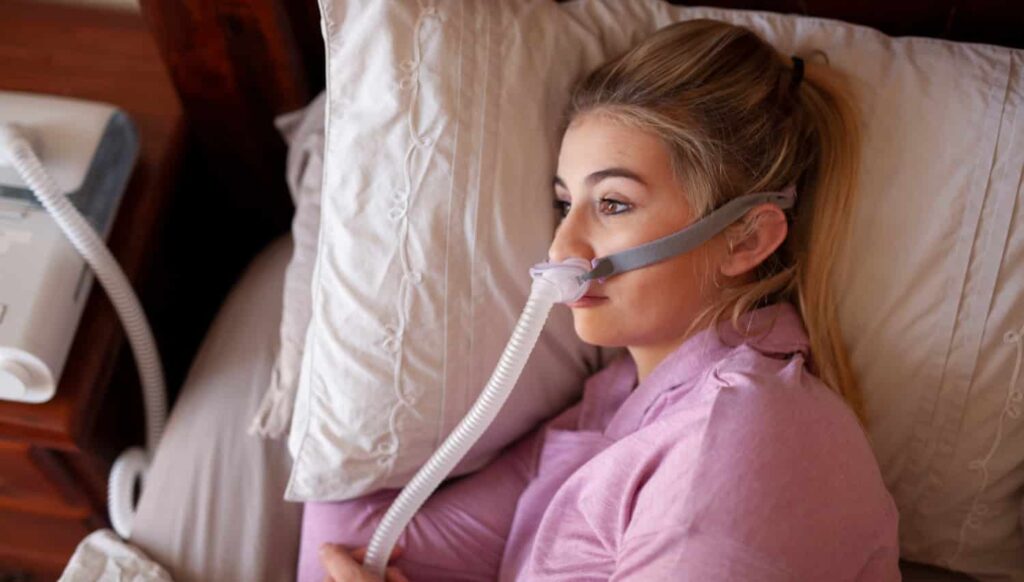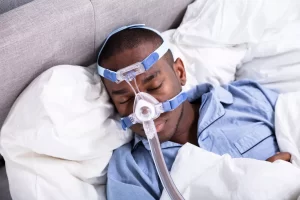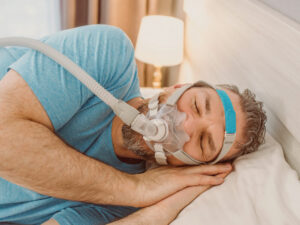Table of Contents
What is CPAP?
CPAP stands for Continuous Positive Airway Pressure. It is a machine that helps people with sleep apnea breathe more easily by delivering a stream of pressurized air through a mask that is worn over the nose and mouth.
Sleep apnea is a condition in which people repeatedly stop breathing during sleep. This can cause a number of health problems, including daytime fatigue, headaches, and high blood pressure.
CPAP therapy is one of the most effective treatments for sleep apnea. It can help to improve sleep quality, reduce daytime fatigue, and improve overall health.
CPAP therapy is not without its challenges. Some people find it difficult to get used to wearing the mask. Others find that the noise of the machine is disruptive. However, most people who use CPAP therapy find that the benefits outweigh the challenges.
If you have been diagnosed with sleep apnea, talk to your doctor about CPAP therapy. It may be the best way to improve your sleep and your health.
Here are some of the benefits of using CPAP therapy:
- Improved sleep quality
- Reduced daytime fatigue
- Improved concentration and alertness
- Reduced risk of accidents
- Improved mood
- Reduced risk of heart disease, stroke, and other health problems
If you are considering CPAP therapy, talk to your doctor. They can help you determine if CPAP is right for you and help you get started with therapy.
Can You Use a CPAP Machine after a Tooth Extraction?
It is generally not recommended to use your CPAP machine after a tooth extraction. The suction from the mask can dislodge the blood clot that forms at the extraction site, which can lead to a painful condition called dry socket. If you develop dry socket, you will need to see your dentist for treatment.
However, there are some cases where it may be possible to use your CPAP machine after a tooth extraction.
If you have a small extraction site and you are careful not to apply any suction to the area, you may be able to use your CPAP machine as usual. It is important to talk to your dentist before using your CPAP machine after a tooth extraction to make sure it is safe for you.
If you do decide to use your CPAP machine after a tooth extraction, there are a few things you can do to reduce the risk of developing dry socket:
- Use a chinstrap to keep the mask from moving around.
- Use a nasal pillow mask instead of a full-face mask.
- Use a heated humidifier to add moisture to the air.
- Avoid using your CPAP machine if you have any pain or swelling at the extraction site.
If you develop any pain or swelling at the extraction site, stop using your CPAP machine and see your dentist immediately.
How Long Should I Wait to Use My CPAP after Tooth Extraction

Unfortunately, there is no definitive answer to how long you should wait to use your CPAP after a tooth extraction. Most doctors recommend waiting for up to 3 days, in order to prevent dry socket. (Read more: Will CPAP Cause Dry Socket?)
Every situation is different, though, and the best advice comes from your healthcare providers who know your specific medical history and the details of your procedure.
Here’s some information to help you understand the potential concerns and make an informed decision:
Concerns with Using CPAP after Tooth Extraction:
- Dry socket: This is a painful condition that can occur when the blood clot at the extraction site dislodges. Some sources recommend avoiding CPAP for up to 3 days after extraction to minimize the risk of this happening, but research on the direct link is inconclusive.
- Mask pressure: The air pressure from your CPAP mask could potentially dislodge the clot or irritate the extraction site. However, some mask types are less likely to cause issues than others.
Factors to consider:
- Type of extraction: Simple extractions generally involve less risk than complex ones.
- Healing progress: Once the initial bleeding subsides and the clot seems stable, the risk of disruption decreases.
- CPAP mask type: Nasal masks may be more likely to cause concerns than full-face masks due to their proximity to the extraction site.
- Severity of sleep apnea: If your sleep apnea is severe and untreated, the risks of not using your CPAP may outweigh the potential concerns.
Here’s what we recommend
- Consult your dentist: They can assess your individual situation and advise on the best course of action, taking into account the specifics of your extraction and your CPAP usage.
- Discuss with your doctor: If you have any underlying medical conditions or concerns, talk to your doctor about the safest way to manage your sleep apnea after the extraction.
- Start with caution: If your healthcare providers approve using your CPAP, begin with lower pressure settings and adjust them gradually as your extraction site heals. Monitor for any discomfort or signs of infection.
What Are the Risks of Using CPAP after a Tooth Extraction?
The risks of using CPAP after a tooth extraction include:
- Dry socket: Dry socket is a painful condition that can occur after a tooth extraction. It happens when the blood clot that forms at the extraction site is dislodged. The suction from the CPAP mask can dislodge the blood clot and increase the risk of dry socket. (READ MORE: Will CPAP Cause Dry Socket?)
- Infection: The suction from the CPAP mask can also increase the risk of infection at the extraction site.
- Pain: The mask can irritate the extraction site and cause pain.
- Discomfort: The mask can be uncomfortable to wear after a tooth extraction.
If you have any concerns about using your CPAP machine after a tooth extraction, talk to your dentist. They can help you decide if it is safe for you to use your CPAP machine and can offer advice on how to reduce the risk of complications.
How to Use CPAP Safely after a Tooth Extraction
First of all, consider waiting 1-2 weeks until the extraction site is properly healed. Only after the healing has concluded, it’s safe to use your CPAP machine.
Here are some tips on how to use CPAP safely after a tooth extraction:
- Talk to your dentist. Before using your CPAP machine after a tooth extraction, it is important to talk to your dentist. They can assess your individual situation and give you specific instructions on how to use your CPAP machine safely.
- Use a chinstrap. A chinstrap can help to keep the mask from moving around, which can reduce the risk of suction on the extraction site.
- Use a nasal pillow mask. A nasal pillow mask is less likely to irritate the extraction site than a full-face mask.
- Use a heated humidifier. A heated humidifier can help to add moisture to the air, which can help to keep the extraction site moist and prevent dry socket.
- Avoid using your CPAP machine if you have any pain or swelling at the extraction site. If you have any pain or swelling at the extraction site, stop using your CPAP machine and see your dentist immediately.
By following these tips, you can help to reduce the risk of complications and safely use your CPAP machine after a tooth extraction.
What to Do if You Develop Dry Socket
Dry socket is a painful condition that can occur after a tooth extraction. It happens when the blood clot that forms at the extraction site is dislodged. This exposes the underlying bone, which can be very painful.
If you develop dry socket, you will need to see your dentist for treatment. Treatment may include:
- Pain medication. Your dentist may prescribe pain medication to help relieve the pain.
- Antibiotics. If there is an infection, your dentist may prescribe antibiotics.
- A medicated dressing. Your dentist may pack the extraction site with a medicated dressing to help promote healing.
It is important to follow your dentist’s instructions after you are diagnosed with dry socket. With proper treatment, most people recover from dry socket within a few days.
Here are some things you can do to help relieve the pain and discomfort of dry socket:
- Apply a cold compress to the outside of your face, over the extraction site.
- Rinse your mouth with warm salt water several times a day.
- Avoid smoking and using tobacco products.
- Eat soft, bland foods.
- Get plenty of rest.
If you have any concerns about dry socket, be sure to talk to your dentist.
When You Can Start Using CPAP Again, after a Tooth Extraction
It is generally recommended to wait at least 1-2 weeks after a tooth extraction before using your CPAP machine again. This will give the extraction site enough time to heal and reduce the risk of complications, such as dry socket.
If you have any pain or swelling at the extraction site, it is best to wait even longer before using your CPAP machine. If you develop dry socket, you will need to see your dentist for treatment before you can use your CPAP machine again.
It is important to follow your doctor’s instructions after a tooth extraction. If you have any questions or concerns, be sure to ask your doctor.
FAQ on CPAP After Tooth Extraction
Can I Use a CPAP after a Molar Extraction?
Using a CPAP after a molar extraction requires caution. While it’s crucial to maintain good sleep for healing, dry socket risk and mask discomfort are concerns. Consult your dentist or doctor for personalized advice. They can assess your situation and recommend if, how, and when to safely resume CPAP therapy to ensure both restful sleep and a smooth recovery.
Can I Use CPAP after Dental Implant?
Using a CPAP after dental implant placement needs a case-by-case approach. The main concern is with the mask pressing on the healing implants, potentially hindering osseointegration (the crucial bone fusion around the implant). Discuss it with your dentist – they’ll consider the location of the implants, healing timeframe, and mask type to determine if immediate CPAP use is safe or if a temporary break is advisable.
Can a CPAP Machine Cause Dental Problems?
CPAP therapy, while vital for restful sleep, can dry out your mouth, increasing cavity risk. The constant air pressure can even stress teeth, potentially causing them to shift or loosen. Choose a well-fitting mask, use a humidifier, and prioritize oral hygiene to minimize risk and ensure you reap the full benefits of this life-changing treatment.
Can You use a CPAP after Dental Surgery?
Using a CPAP after dental surgery depends on the details of your procedure and mask. Consult your dentist. For most minor procedures, resuming CPAP after a few days is fine with proper mask adjustments to avoid discomfort. But, for some sensitive oral surgeries like extractions, a temporary break (3-7 days) might be safer to minimize dry socket risk.




